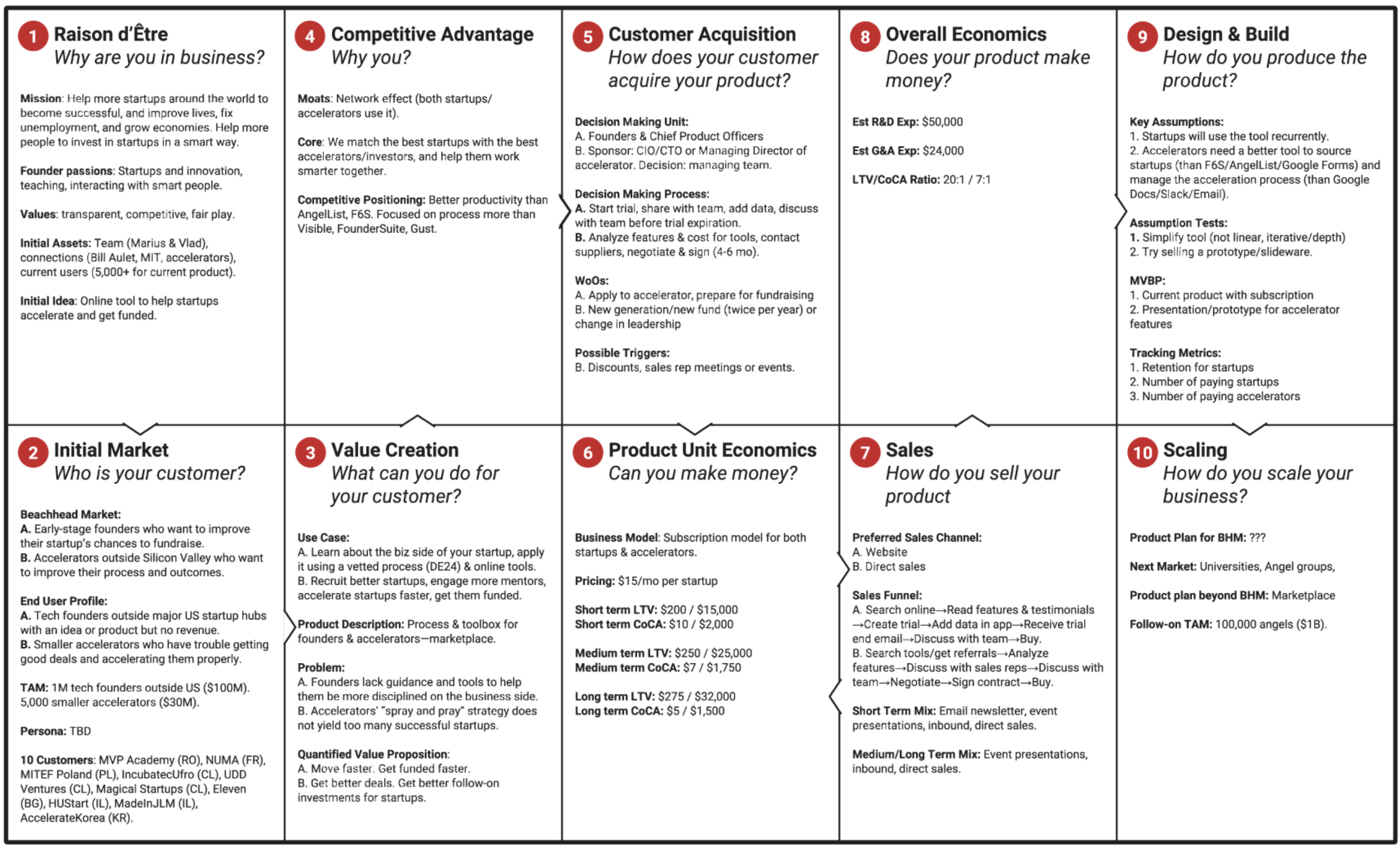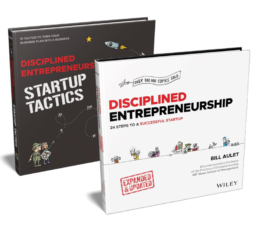DE Canvas
The DE Canvas tracks your progress and can also be used as a diagnostic tool for a business to find its strengths and weaknesses. Its value and its flaws are based on its ability to simply convey the current status of a business on one page. When it is understood that the boxes are dependent in a cumulative manner, the DE Canvas gives valuable insights into yet another dimension of the interrelationship of the different elements of your business and its ongoing sustainability.
At this point in the book, you will not be able to fill the canvas out or even probably understand all of the elements in sufficient depth but it is something that you can come back to as you progress through the book. It will then be a valuable tool for monitoring the ongoing strength of your plan. The canvas, like your plan, will be continually updated as you learn more throughout the 24 Steps.
Videos
Credits: Andy Acevedo, TKF Studios
Worksheets
Examples
Content will be published as it becomes available.
Topics
More Detailed Description of Using the DE Canvas to Evaluate Marius Ursache’s DE Toolbox Project
As we described at a high level in the primary part of the chapter in the book this use of the DE Canvas to evaluate and diagnose strengths and weaknesses in Marius Ursache’s DE Toolbox project, here we will do so in more depth.

After a quick review of this DE Canvas, a few things stand out to me that will direct our discussion, guidance, and actions going forward. On the positive side, this team/project seems to be getting off to a good start as the foundation in the first few boxes is strong. The raison d’être is strong, as are the original assets and there is a strong understanding of the marketplace. The team is also demonstrating discipline in narrowing the scope of the market they will serve initially, but as with almost all projects I see, I would like to see an even more focused market segmentation. This is version 1.0 so I am less troubled. There is compelling evidence that the problem and opportunity is well understood. Looking at the team’s background, there is little concern about being able to build the product.
I am less confident but not too worried about the long-term competitive advantage. While they describe a logical plan (i.e., network effects), achieving it will be a real challenge especially when we get to the areas of concern. As we look across the Canvas, my confidence in the scaling dimension of this business is not high based on current information.
My biggest concerns however that jump out are regarding the product unit economics and revenue (boxes 6 and 7). but executing to make that plan a reality is the question. It starts when I see the pricing of $15 per month per startup. This leads to an LTV in the $200-$300 range which sets off red flags for me. This is a consumer-level LTV for a product that is really a B2B (business-to-business) proposition. Even when selling to accelerators, the LTV is in the low thousands of dollars which is going to take time and even then, optimistic. As I now direct my focus to boxes 6 and 7, I see genuine efforts to try to address this using digital marketing tools but even the team has to acknowledge it will take some direct sales.
Without the unit economics working, there is no way the overall economics (box 8) will work. It is not even worth worrying about them because unit economics is a necessary condition for the overall economics to work. It is the first test. Without this as well, it will be probably impossible to achieve network effects as was discussed above.
It is very hard to scale a business that has not conquered it beachhead market. Some might say that is okay to lose money in the beachhead market (this assumes you can find investors to take this risk which is certainly not a given especially if you don’t live in Silicon Valley) if there is a clear path to an extremely scalable business. But again, box 10, Scaling, does not give us that comfort even if that was a path we wanted to pursue.
The larger point from this example is the power of the DE Canvas. Napoleon Bonaparte was renowned for his ability to quickly assess a battlefield and determine an effective strategy. This talent, combined with his comprehensive understanding of the discipline of warfare, made him one of the most formidable military leaders in history. We are not fighting military battles but the DE Canvas just you the ability to quickly scan the landscape for your proposed or existing business and figure out rapidly if it has the potential to be an attractively scalable venture/product.
It also gives you the ability to focus on the areas of highest concern, as well as the areas you have the strongest position. This is very helpful. Its limitation is that it does not give you the richness of details that you will want as you ask more questions but that is fine. It is but one page and your plan will be much more robust and able to handle the follow-up questions, and if not, you just got some great advice.
Detailed Box-by-Box Analysis:
① Raison d’Être: The founder’s passions, values, initial assets, and initial idea are good and can be refined, but the real area I would focus on is the mission. It is too general and is not unique or inspiring. Having a clear mission is valuable for two reasons – it shows why the world will be a better place thanks to your venture which makes it more than just profiteering, and, equally important, it tells you what you will not be doing. This guidance on what you will be not doing will help you to get the right people on your team. To build a successful team you need three things: a common vision, shared values, and complementary skills. Clarity on why you are in business is fundamental to your success in an environment that will be fraught with failure and other discouraging moments. That common vision keeps you marching on.
② Initial Market: Again, there is lots to like in the End User Profile, TAM, and Next 10 Customers. The beachhead market and Persona draw my attention and concern. First, I worry that the beachhead market is two different markets. There cannot be a plural of beachhead market. Second, I worry even more that there is no Persona. I know picking a Persona can be a bit uncomfortable and you will not find the perfect one to start, but Marius should pick the best one he has and then execute the process with it and look to upgrade the Persona over time.
③ Value Creation: When you simplify things down to a one-page summary, there is a tradeoff made. When a great deal of information is summarized in a small box, some things have to be left to future follow-up. The Use Case is one example as you can see here. Marius has summarized it here but there are still a lot of questions, which is a good thing. This is encouraging but I definitely want to see the product brochure. But all in all, good. At this point, it is clear that the plan is for a two-sided market which was foreshadowed in the second box by description of two complementary beachhead markets.
④ Competitive Advantage: In the moats section, Marius lists “network effect,” but I think that is actually the Core. What Marius lists for the Core definitely is not a Core, but rather is the benefit that customers will get. A Core is an internal capability that you will have uniquely or much stronger than anyone else. I worry when I see networking effects as a Core because while it can be a great one, it is rarely achieved, and if is not achieved, then the company has no defensible advantage over others who will be able to follow you into the market at a lower cost by learning from the first mover’s mistakes.
⑤ Customer Acquisition: The Decision-Making Unit (DMU) seems to be too simplistic (although I like that he has identified the chief product officer). Who are the DMU’s primary influencers? The Decision-Making Process is too simplistic and does not address creating awareness with the target market enough. The windows of opportunity are a good start but the possible triggers section is not developed in any creative way. This section, like much of the Canvas (and like what I’d expect for a first pass on any Canvas), is too general and lacking in specifics to this situation.
⑥ Product Unit Economics: I like that these are general estimates and that they do not try to convey a level of precision that is not attainable at this point. The short-term COCA of $10 seems absurdly low to me and I am confident that upon closer evaluation, Marius will find this number to be much higher, which is expected in the short term. It would be extremely unusual to see a short-term LTV of $200 with only a short-term COCA of $10, or a short-term LTV of $15,000 with a short-term COCA of only $2,000. This immediately makes me discount the medium-term and long term where I am confident that the COCA is still too low. But if the LTVs are to be believed, the business will be able to handle the actual COCA. Notice how easy it is to get a sense of the business from just a few numbers!
⑦ Revenue: Oh my goodness! With the very low COCA from the previous section, I expected to see no direct sales channel utilization in this section (eschewing direct sales is risky in the short term), but there it is as the second option. He’ll really need to think about how to minimize the use and cost of direct sales (likely use inside sales instead of field sales, for starters) and to use other sales methods to keep COCA down. Maybe he can do online chat sales early on so that inside sales is more affordable. I think “robo-sales” using big data analysis and preference engines is probably the way to go. I am feeling even less good on the COCA calculations now, and I would dig deeper to make sure the unit economics model gets refined. The mentality of the organization needs to be more focused on designing the sales process to have no human interaction from the company’s side in the near future, so that the COCA does not grow out of control.
⑧ Overall Economics: The R&D expense and the G&A expense items seem reasonable since the work is being done in Romania, not the United States, but the LTV/COCA ratio still bothers me because I think the actual COCA is higher. However, this part of the Canvas shows me that if the LTV is accurate, there is room for the COCA to be higher and still have an economically sustainable and attractive business entity.
⑨ Design & Build: The key assumptions are too few and too general. The assumption tests do not yet line up with the key assumptions. The MVBP is already up and running, so there is valuable information that can be gained from this investment so far. The tracking metrics are generally correct, but are also more general than I would like to see; for example, they do not have a time frame indicated.
⑩ Scaling: What Marius put here is very general, but that is not as much a problem as it would be in the other sections, because you won’t have much clarity this early on. That being said, Marius should keep an eye on this section going forward and update it quarterly based on new information that will be coming in as he engages in the market and learns from iterations on earlier steps.
Course on Financial Literacy for Entrepreneurs
There is a free online course by MIT professors on Financial Literacy that will help you understand the Unit Economic box 8 on the DE Canvas. It covers this topic in great depth. It is listed here because this material is not covered in the Disciplined Entrepreneurship book.
Books
Content will be published as it becomes available.
Other Resources
Content will be published as it becomes available.
The Disciplined Entrepreneurship Toolbox
Stay ahead by using the 24 steps together with your team, mentors, and investors.
The books
This methodology with 24 steps and 15 tactics was created at MIT to help you translate your technology or idea into innovative new products. The books were designed for first-time and repeat entrepreneurs so that they can build great ventures.

